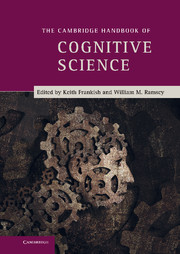Book contents
- The Cambridge Handbook of Cognitive Science
- The Cambridge Handbook of Cognitive Science
- Copyright page
- Contents
- List of figures and tables
- Contributors
- Acknowledgments
- Introduction
- Part I Foundations
- 1 History and core themes
- 2 The representational theory of mind
- 3 Cognitive architectures
- Part II Aspects of cognition
- Part III Research programs
- Glossary
- Index
2 - The representational theory of mind
from Part I - Foundations
Published online by Cambridge University Press: 05 August 2012
- The Cambridge Handbook of Cognitive Science
- The Cambridge Handbook of Cognitive Science
- Copyright page
- Contents
- List of figures and tables
- Contributors
- Acknowledgments
- Introduction
- Part I Foundations
- 1 History and core themes
- 2 The representational theory of mind
- 3 Cognitive architectures
- Part II Aspects of cognition
- Part III Research programs
- Glossary
- Index
Summary
- Type
- Chapter
- Information
- Publisher: Cambridge University PressPrint publication year: 2012
- 7
- Cited by



